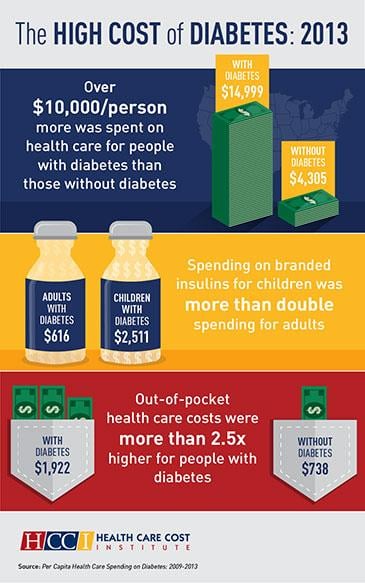Take a guess: How much more money is spent on medical care for people with diabetes than those without diabetes?
A May study from the Health Care Cost Institute found that among adults with employer-sponsored insurance, average per capita spending for those with diabetes is nearly $15,000—about $10,300 more than for those without diabetes.
The study also found that the out-of-pocket health care spending by people with diabetes was more than 2.5 times higher than for people without diabetes.
The findings underscore the importance of a newly introduced bill that could help reduce the incidence of diabetes and help to control costs. The Medicare Diabetes Prevention Act would require Medicare to cover services provided under the evidence-based National Diabetes Prevention Program.
Although the study examined individuals with employer-sponsored insurance, the high cost of diabetes affects the Medicare population, too. A study released last year estimated the bill could reduce federal spending by $1.3 billion over 10 years.
The study also estimated that the legislation would help reduce the cumulative rate of type 2 diabetes in the Medicare population by an estimated 37 percent after a decade. That means there would be nearly 1 million fewer cases of diabetes among seniors by 2024.
Stopping type 2 diabetes before it starts
Part of controlling the spiraling costs of treating patients with type 2 diabetes is preventing the disease before it starts. That’s why the AMA’s Improving Health Outcomes initiative is focused on prediabetes, the precursor to type 2 diabetes.
In 2012, the Centers for Disease Control and Prevention (CDC) launched the National Diabetes Prevention Program based on research led by the National Institutes of Health, which showed that individuals at high risk of developing type 2 diabetes who participated in structured lifestyle change programs saw a significant reduction in the incidence of the disease.
The AMA spent the past year working with the YMCA of the USA and 11 physician practice pilot sites in four states to increase physician screening and testing for prediabetes. Physicians in the pilot then referred patients with prediabetes to diabetes prevention programs offered by local YMCAs that use the CDC’s program. Medicare beneficiaries were able to participate in this program at no cost, thanks to an award from the Center for Medicare and Medicaid Innovation.
What physicians can do now
To help physicians and care teams address the growing prevalence of prediabetes, the AMA and the CDC recently announced a call to take urgent action with Prevent Diabetes STAT: Screen, Test, Act – Today™. The multi-year initiative will help physicians refer patients to diabetes prevention programs in their communities or online. Get the toolkit now.
Learn more about diabetes prevention programs and the AMA’s Improving Health Outcomes initiative at AMA Wire®.




